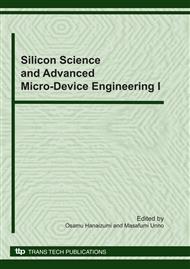p.71
p.78
p.84
p.92
p.100
p.111
p.116
p.120
p.124
The Hydrophobicity of Micro Water Pool and the Interfacial Fluidity of PC-Based W/O Microemulsion Droplet Involved with Reactivity of Phospholipase A2
Abstract:
The impact of physicochemical character of the W/O microemulsion droplet on the reactivity of phospholipase A2 (PLA2) was investigated for optimal design of the micro-reactor. Hydrophobicity of micro water pool and fluidity of micro-scaled interface of W/O microemulsion droplet were dominant factors to determine the appearance of maximum reactivity. Phosphatidylcholine (PC) in this system performed not only as a substrate for PLA2 but also as an amphiphilic molecule to form W/O microemulsion droplet. The organic phase was composed by isooctane (C8*) as a main solvent and 1-butanol (C4) as a co-solvent. The molar ratio was fixed as isooctane:1-butanol =11:1. The water content in the W/O microemulsion was indicated by the molar ratio of H2O moles to PC moles presented by Wsoln [-](≡[mol-H2Osoln]/[mol-PC]). By the increasing of the water content from 1 to 5, the reactivity of PLA2 was remarkably increased from 0.01 to 0.03 [mM・s-1・mg-PLA2-1]. Over 5 of Wsoln range, the reactivity was decreased. The optimal water content was indicated as Wsoln=5 [-]. The hydrophilicity of micro water pool and the interfacial fluidity of the water pool were detected by the signal of the fluorescence probes, Coumarin 343 and TMA-DPH, respectively. The hydrophobicity was decayed with the increasing of the water content. More than 10 of Wsoln, the hydrophobicity was fully decayed and achieved to bulk aqueous one. The interfacial fluidity was decreased with the increasing of the water content. In more than Wsoln of 5, the reactivity was decreased by the decline of the collision frequency between PLA2 and PC molecule due to lower fluidity of micro-scaled interface.
Info:
Periodical:
Pages:
100-108
Citation:
Online since:
December 2010
Authors:
Price:
Сopyright:
© 2011 Trans Tech Publications Ltd. All Rights Reserved
Share:
Citation:


